Muay Thai | Prior to the Selection | Before the date for Mauythai day was selected, experts from various fields considered toward Muay Thai , ranging from monarchs to commoners. They included King Ramhamhaeng the Great, King Naresuan the Great, King Sanphet VIII (Phrea Chao Suea), King Buddha Yot Fa Chulaloke the Great, King Buddha Loes la Nabhalai, King Nang Klao, King Chulalongkron the Great, Phraya Phichai daab Hak and Nai Khanomtom. The Cabinet later Approved a proposal to declare February as the month for “Muay Thai Day,” in honor of King Sanphet VIII (Phra Chao Suea) the father of Muay Thai who promoted the martial art during his reign. He was a grand master in Muay Thai who commanded descriptions of Muay Thai techniques and tactics to be recorded into a volume know as the “Muay Thai Textbook in the Style of Phra Chao Suea”.
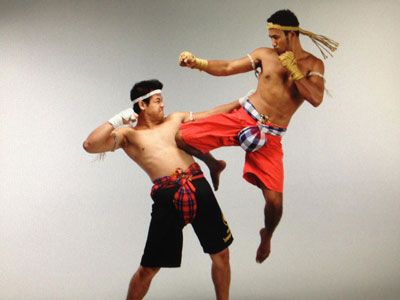
Thus VI February each year was selected as Muay Thai Day. This was based on the anniversary of the coronation day of King Sanphet VIII on VI February 1702.
History of Muay Thai
Sukhothai Period (approx. 1238-1375 A.D.) The Muay Thai or weapon training was done for the purposes of exercise and preparation in readiness for war, as well as for trials of strength and tactics for demonstration fighting at festive occasions. The Sukhothai laws mentioned that in boxing, a temporary ring was set up at the temple fairs or in the celebration areas. Boxing was an art of self-defence, a respectable tradition, not an activity for gambling, therefore there was no payment of duty required in the Kingdom.
Period (approx. 1350-1767 A.D.) The most important thing was that the Thai believed in Muay Thai as the prime art of self-defence, which could cause body disability, the damage caused possibly being fatal. The boxing competitions were not organized regularly, except at royal celebration, traditional festivals or major holidays. The prizes were mostly in kind;if money was awardee, it would not be a large amount. Many Ayudhaya kings were experienced boxers and were interested in watching the game, especially Phra-chao Seua (“King Tiger”-his nickname) who fought three famous boxers of Wisetchaichan, a city of that period.

Thonburi Period (approx. 1767-1782 A.D.) The aim of Muay Thai training was for military purposes, national defence, keeping the peace in the kingdom, and the protection of the king, as well as defence of self, family and community. The reason for this was because during the time of turmoil the number of evil-doers increased. The king himself was good at Muay Thai and Krabi-Krabong. He trained with the Taniluek and other famous camps, and often watched boxing matches. Thonburi’s Muay camps were similar to those of Ayudhaya; there was a training centre in the palace, for use by members of royalty and nobility, and army officers; in the village and temple boxing centres, experienced warriors and boxers who had become monks trained those who applied to be pupils, giving service in return for the guidance of the teachers.
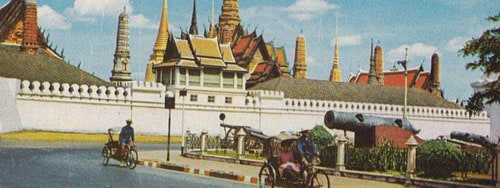
Ratanakosin Period (approx. 1782 A.D. – present)
No Translation …
Muaythai – Intangible Cutural Heritage
Muaythai belongs to Thailand’s intangible cultural heritage. The origin to this traditional Thai martial art can be traced back to the dawn of the nation’s history. It is the art of efficiently using nine body parts viz. two fists, two feet, two knees, two elbows, and the head as weapon (called Nava-arvudh in Thai). Muaythai is not only important at individual, community, social, and national levels, but also has long plays a vital part in protecting the kingdom’s sovereignty.
In the past, Muaythai was a martial art that most Thai man had to learn and train. It is said that Muaythai is the basic art of fighting, use of weaponry is a secondary skill, and fighting strategies are the key to victory.
To practice Muaythai, one needs to be wily, astute, and knowledgeable. The Thai Royal Annals note that monarchs usually mastered Muaythai fighting while high-ranking royals, military noblemen as well as commoners were trained in the martial art for the practice of Muaythai also helped to optimize the use of weapons such as the Krabi (curved sword), Krabong (short wooden staff), Plong (wooden staff), sword, Ngao (halberd), and Thuan (lance), especially in close fighting.
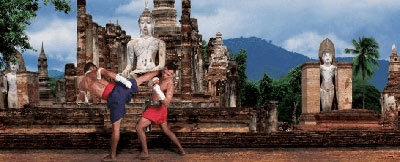
When the kingdom was not at war, Muaythai contests became common for those who wanted to pit their strength and fighting skills against worthy opponents. The Law of the Three Seals, Section Miscellany, mentioned boxing as: “117 Article 1 – If two persons made a voluntary agreement to box or fight with each other and one of them was hurt, had broken bones or even died, the other would not be penalized”
As such, Muaythai has been important at individual, community, social, and national levels as well as playing a vital role in maintaining the kingdom’s sovereignty.
Muay Thai | A Combination of Tactics and Physical Strength
The unique characteristics of Muaythai that make it one of the most refined martial arts are the use of limbs to defend and attack in lieu of shields and weapons. Muaythai does not rely purely on strengthand power it also depends considerably on techniques, tactics, and strategies. Boxers need to body to defeat opponents. There are many striking tactics to deliver blows and they allow the aggressor to attack from many different angles with speed and power, continually keeping his opponent off balance.
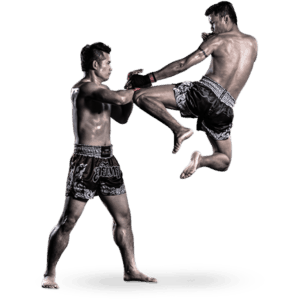
Muaythai training comprises three steps
- Basic step | Learn self-protecton before attacking other, i.e. Pong, Pat, Pid,Perd (guard, block, ward-off, and open defense).
- Intermediate step | As fighters in the ring, boxers should learn to approach and counterattack, i.e. Thum, Thub, Jub, Hak (slam, press, hold, and break [including eye gouging]).
- Advanced step | To become a warrior or instructor in case of ear, and to serve as an emissary, scout, soldier, squadron leader, and commander-in-chief. This includes the art of killing which is not commonly taught. The step comprises stealthy approach, surprise, immobilization, and death blow (breaking of the neck).
Muay Thai Style | Five Styles of Muaythai
The five Muaythai styles have the same basic principles | using limbs to create over a hundred means of continuous striking. Practitioners from different parts of the country also developed different tactics, techniques, and skills, “Heavy punch Korat, clever mave Lop Buri, goof tactics Chaiya, Repid tha sao, Maneuverable palasucksa”.
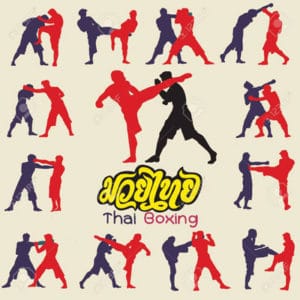
Lop Buri style – Clever and swift offensive and defensive combinations with quick straight jabs. The style is also called “Muay Kiew” as it uses many tactics to distract the opponent. With sharp eyes, the defender employs lightning hand, feet, Knees, and elbows.
Korat Style – This is characterized by the “Kaad Chuek” method (binding or wrapping of rope or fabric around both palms and the back of the hands and wrists), the defensive stance, training, and striking methods. Signatures of this boxing style include a heavy and wide side – punch called “Wiang Kwai” (Swing the Buffalo)
Chaiya style – Originating in Chaiya District, Surat Thani Province, this style became well – known after the fifth reign, it also includes the “Thum, Thub, Jub, Hak” (Slam, press, hold, and break) techniques. Muaythai vernacular was usually coined in rhyme but contains profound meanings such as Pong, Pat, Pid, Perd (guard, block, ward-off, and open defense).
Tha Sao Style – From Uttaradit Province, the style is showcased by a wide defensive stance, putting the weight into the rear foot, front foot slightly touching the ground for swift movement and long, hard straight punches. The front fist is raised above the shoulder, the other is lower. Another style of Tha Sao created by Phraya Pichai Daab Hak (Phraya Pichai of the broken sword) combines both hard and soft techniques. Striking can be modified in accordance with the situation; learning weak and strong points of the opponent and oneself is a key component.
Palasueksa Style – This refers to combat by practitioners who have learned other boxing and Muaythai styles before adopting additional techniques at the Physical Education Institute from Mr. Kimseng Taweesith, a famous Muaythai master who inherited the art of Muaythai from His Serene Highness Prince Vibulya Svastiwongse Svastikul. The prince learned international – style boxing from abroad and is dubbed the “father of International – style Boxing of Thailand”. This style emphasizes agility and alacrity – so – called fully – fledged muaythai.
The Talisman of muaythai
In this context, amulets and talismans are auspicious objects used to boost fighters’ morale. It is believed that sacred amulets and talismans can afford protection against weapons and add to the fighters’ strength.
Mongkhon and Prachiat are made of thread, ropes or cloth strips intertwined and tied to form a ring consecrated with magical mantra or conjuration by grand master. Amulets and Talismans A Superstitious Power.
MongKhon is a type of headgear, deemed the most auspicious object for Muaythai boxers. It represents fortune, good luck, happiness and vigilance. Highly revered and believed to provide boxers with protection, MongKhon is usually made of consecrated thread, ropes or cloth strips intertwined and tied to form a ring.
Prachiat is like an armband. It is made of rope or red cloth inscribed with magical runes and tied around the neck or the bicep. It is believed to provide protection.
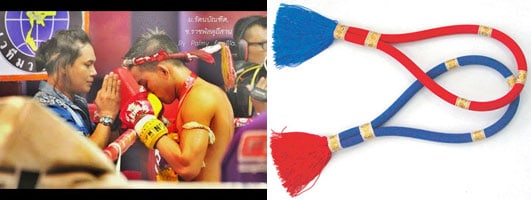
Boxing Stance
Mae Mai Muay Thai
Mae Mai Muay Thai or Mae Mai employ combinations of fists, feet, knees, and elbows for offensive and defensive purposes. To master the art of Muaythai fighting requires regular practice of striking and defending maneuvers, the name of which have been adapted for easy recollection. When these stratagems were developed, they were categorized into groups and rhymed. In antiquity, Muaythai was usually fought bare-fisted or with cloth-bound hands so it was easy to snatch, break, or twist opponent’s body parts. Tactics were more important than strength.
Out of hundreds of Muaythai techniques and tactics, only 15 are considered as Mae Mai Muaythai or master techniques.
Portraits of these master techniques, the gold leaf paintings by Mr. Vallabhis Sodprasert, are provided on the following;
1. Salab Fun Pla (Zigzag) – Basic evasion of an opponent before beginning another attack.
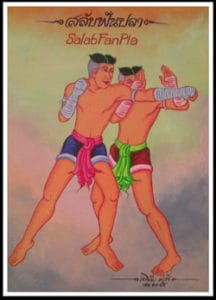
2. Paksa Waek Rung (Bird Parting the Nest) – For approaching the opponent before striking.
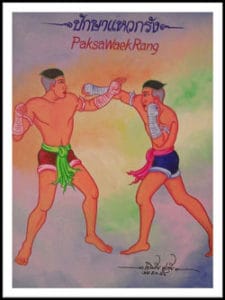
3. Java Sad Hok (Jaba Throws Spear) – For avoiding straight punches and counterattack with an elbow strike.
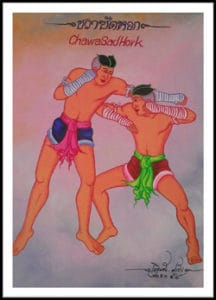
4. Inao Tang Krit (Inao Uses Dagger) – For blocking straight punches before approaching an opponent.
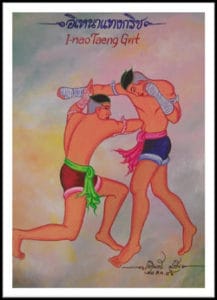
5. Yor Khao Phra Sumane (Lower Suneru Mountain) – For cucking a straight punch, approaching and then attacking with uppercut.
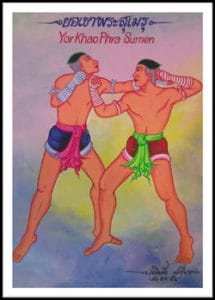
6. Ta Then Kham Fug (Monk Stakes Gourd Plant) – For blocking a straight punch with an arm and striking back, aiming at the chin.
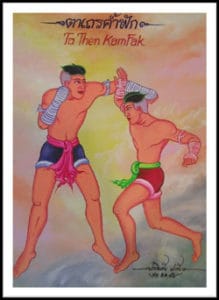
7. Mon Yan Luck (Mon Hold a Post) – For striking back at a straight punch, by push kicking at the chest or abdomen.
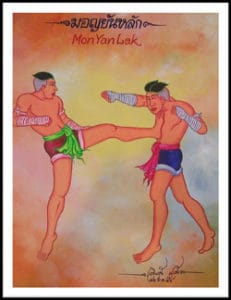
8. Pak Luk Thai (Sticking Luk Thoi) – Used to counter a roundhouse kick by throwing an elbow strike at the attacker, shin.
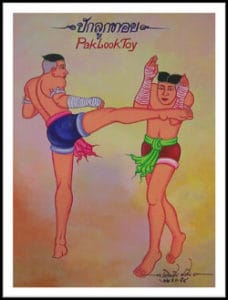
9. Chorakhe Fat Hang (Crocodile Whipping its Tail) – Characterized by using the heel to hit the opponent,s back when he is throwing a powerful punch, but losing his balance, making his back unguarded. The fighter will thus turn his body to throw a swinging heel kick to the kidney. This could damage the attacker’s kidney.
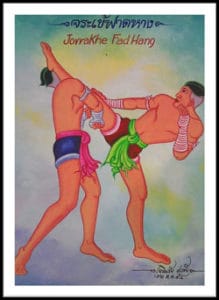
10. Hak Nguang Aiyary (Breaking the Elephant’s Trunk) – Used to block a kick by throwing an elbow strike at the top of the attacker’s thigh to suppress the strength of the kick.
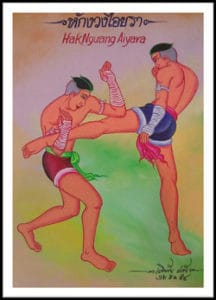
11. Nakha Bit Hang (Naga twisting its Tail) – Used to block a kick by grabbing the attacker’s kicking foot and then twisting the tip of the food, and concurrently striking the calf with a knee.
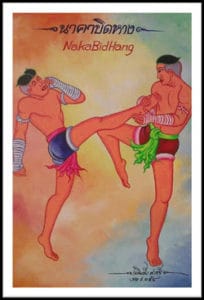
12. Wirun Hok Klap (Demon Wirun Turning over) – Used to defend against a kick by throwing a heel at the top of the attacker’s thigh. This can cause the attacker to suffer a sprained leg.
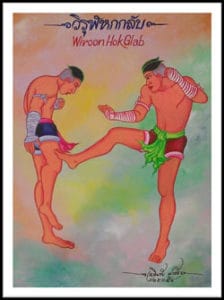
13. Dub Chawala (Put out Lamps) – For counter striking a straight punch, by throwing a straight punch back at the face or eye.
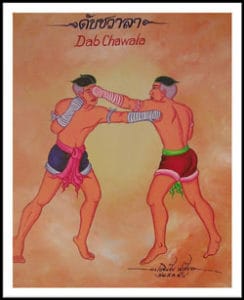
14. Khun Yak Chap Ling (Lord Demon Catching Monkey) – Used in basic training called ruam Mai (Combined Tricks). The protagonist attacks by throwing a punch, a kick, and elbow strike in a fighting sequence. The defender executes a defense sequence of a punch, kick, and elbow strike.
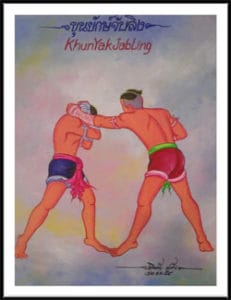
15. Hak Kho Erawan (Breaking the Neck of the Erawan Three-Headed Elephant) – This technique is used to attack an opponent who is approaching with a leg bent. The fighter steps on the knee and throws an elbow strike at the middle of the opponent’s head.
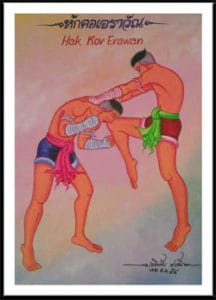
Luk Mai Tactic
Luk mai (tactic) means techniques of using of other tricks that can use of fists, kicks, elbow, and knees, faster and better to attack and gain the victory. According to the standard Thai Boxing teaching, these are divided into variations, namely and body. Luk mai muay thai has 15 form are :
1. Erawan Soei Nga (Erawan Thrusts Tusks) – This is to counter an opponent’s punches by turning the body to pusk them away using forearm and striking back with an uppercut.
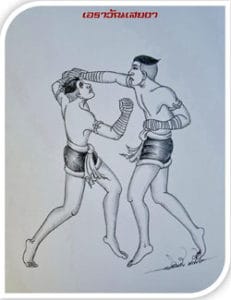
2. Batha Lup Phak (Foot Touching the Face) – Characterized by using a hand to swipe the straight punch away and counterattacking with a push kick aimed at the attacker’s face.
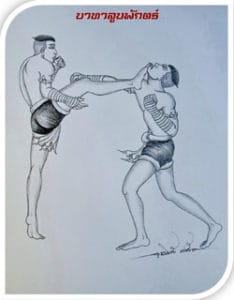
3. Khun Yak Pha Nang (Lord Demon Abducting a Lady) – Characterized by stepping into close quarters, using an arm to enfold the opponent’s trunk, and throwing him down with the hip. Currently, this Technique is not allowed in the ring.
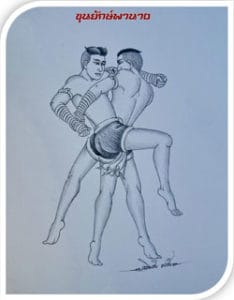
4. Phra Ram Nao Son (King Rama Pulling the Arrow String) – Used for countering an elbow strike from above by ducking th body and bending an arm to push over the attacker’s elbow, then riposting with a punch.
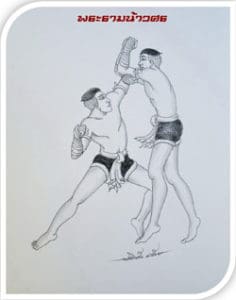
5. Kraison Kham Huai (Lion Crossing the Brook) – Used to block a high kick aimed at the face by shooting a push kick at the attacker’s standing leg.
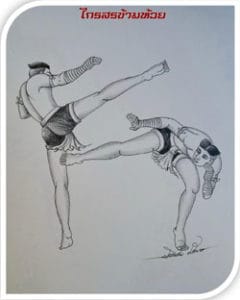
6. Kwang Liao Lang (Deer Turning the Neck to Look Backward) – Used for an attack which begins with a kick or push kick, followed by a kick or a heel kick at the opponent’s chin or upper abdomen.
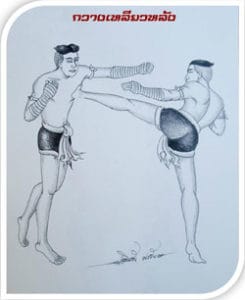
7. Hiran Muan Phaendin (Demon Hiranyasha rolling the Earth) – A major ploy characterized by throwing a swinging back elbow to the attacker no matter whether he attacks with a punch, a knee, or a kick.
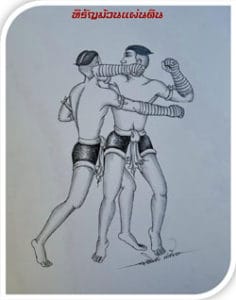
8. Nak Mut Badan (Nago Sneaking to the Ocean) – Characterized by ducking the body in order to let the attacker’s kick pass over the head and shooting a push kick at the attacker’s standing leg to make him fall down.
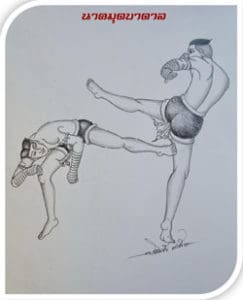
9. Hanuman Tawai Whan (Hanuman Gives a Ring) – For countering a punch or kick strike by turning the body and approaching at close range and throwing double punches at the opponent’s chin.
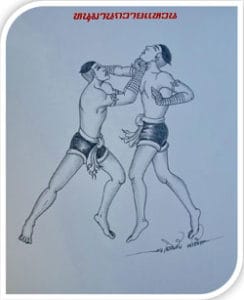
10. Yuan Thot Hae (A Vietnamese Casting a Fishing Net) – Used to block a push kick by swiping the attacker’s leg to make him lose balance before stepping aside and throwing a kick at the back of his knee joint.
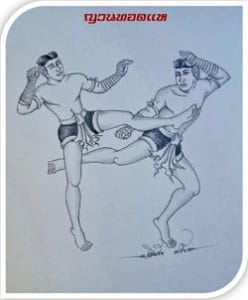
11. Thayae Kham Sao (Thayae Propping up the Pillar) – Used for countering a kick or push kick by ducking the body and quarding against the kick with an arm, while shooting a push kick at the attacker’s standing leg to make him fall down.
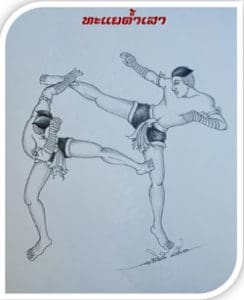
12. Hong Pik Hak (Swan with Broken Wings) – Characterized by stepping quickly into close quarters and striking the attacker’s shoulder socket with an elbow. Such a strike can dislocate or sprain the attacker’s shoulder.
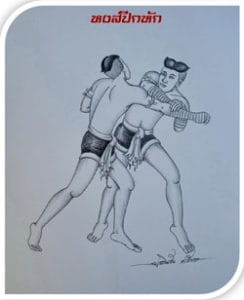
13. Sak Phuang Malai (Making a Ring of Flowers as Necklace) – Used in close fighting, characterized by throwing an elbow uppercut at the ribs or the upper abdomen of the attacker.
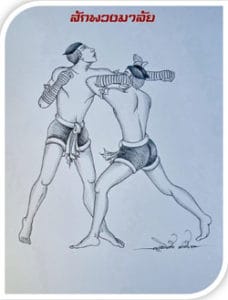
14. Then Kwat Lan Wat (An Old Monk Sweeping the Temple Ground) – Used to attack the opponent’s lower parts. It is characterized by throwing a strong kick at the lower calf.
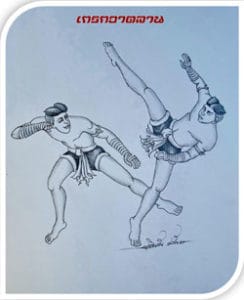
15. Fan Luk Buab (Slicing the Gourd) – Characterized by approaching the opponent quickly and throwing an elbow slantingly to his face.
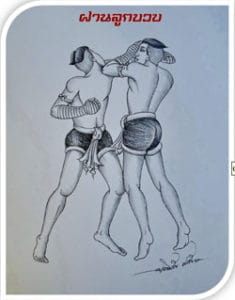
Muay Thai Wai Khru Ritual
According to ancient tradition, before Muaythai fighting starts, the Wai Khru to pay homage to the teacher or master of Muaythai is required. This offers blessings and boosts morale of the fighters.
The ritual is accompanied by the Wai Khru. It is not only the way to study the stance and fighting style of the opponent, but also the best way to stretch and warm up the body, relieve stress and prepare body and mind to be ready for battle.
Wai Khru before the fight is divided into two parts. Part 1: Seating Stances and Part 2: Standing and Dancing.
Part 1: Seating Stances comprise 3 movements: Thep Phanom (Angel in Adoration), Pathom (Beginning Stance), Phrom (Brahma Stance)
Part 2: Standing and Dancing comprise Thep Nimit (Angle Offers Auspice), Nok Yoong Hang (Peacock Spreads Tail), Narai Kwang Chak (Narayana Throws a Disc), Payak Dom Kwang (Tiger Prowls on a Deer), Yang Sam Khum (Three Step Boxing Walk), Khum Choeng Khru (Stalemate), Do Dussakorn ( Look at the Opponent), Fon Long Choeng (Tempting the Opponent)
Wai Khru Muay Thai begins with the following stances.
1. Thep Phanom (Angle in adoration) Phra Mae Thorani-Chest-Head Pathom (Beginning Stance)
Phrom (Brahma Stance) Thep Nimit (Angel offers Auspice) Nok Yoong Fon Hang (Peacock Spreads Tail) Narai Kwang Chak (Narayana Throws a Disc) Payak Dom Kwang (Tiger Prowls on a Deer)
After Payak Dom Kwang, the dance will follow this pattern: 1. Yang Sam Khum (Three Step Boxing Walk) 2. Khum Choeng Khru (Stalemate) 3. Do Dussakorn (Look at the Opponent) 4. Fon Long Choeng (Tempting the Opponent)
Kru (Khru)
“kru” a Thai word, means the person who teaches pupils, “Sid” or who passes on knowledge to pupils. Normally Krus are highly respectestd in Thai society. They knowledgeable, full of perserverance. They practice high moral standards in their way of life leading very respectable lives. They study hard in order to acculmulate knowledge and reveal the knowledge to the pupils without concealing. They always sacrifice themselves and are patient in performing their teaching commitment until their pupils attain full knowledge and are successful and progress in their passing down profession. They light the candle of wisdom to the pupils and lead them out of the darkness. Krus always have the following three gualities: wisdom, kindness, and purity or without hatred, malice or ill will. Their teaching and guidance play the most important role in formation of the pupils’ characters. Such a Kru is usually rewarded by his sense of achievement, respect from everyone and an increase in the number of students who are willing to submit to his guidance.
History of Nai Khanomtom (Father of Muay Thai)
Nai Khanomtom | Orphan Nai Khanomtom was bullied by Aeydam while growing up, prompting him to take up MuayThai. Later, the pair became friends and promised to fight against the advancing Burmese army together. Before the Burmese arrived in Krungsriayudhaya, they had to pass Khanomtom and Aeydam’s hometown of Pamok. They split into two groups: Aeydam and his team would fight the Burmese while Khanomtom’s team went to Krungsriayudhaya to monitor the opposition troops’ movements there. But Khanomtom was caught and imprisoned. Later, on the new chedi celebration day, Prajaomangra, the head of Burma, ordered Khanomtom to display his MuayThai skills, promising to help the Thai if he could beat nine of his soldiers.
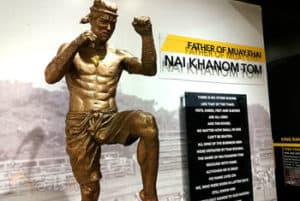
Establishment of Muay Thai Day
All involved parties must make concerted efforts to conserve and promote Muaythai at national and international Levels. On 3 May 2011, the cabinet issued a resolution for creation of Muaythai Day on 6 February of every year. This date marke the anniversary of the Coronation of Phra Chao Suea or King Sanphet VIII as the 29th monarch in the Ayutthaya Period, the king who truly mastered the art of Muaythai.
In addition, all entities concerned should unite in organizing activities to honor Phra Chao Suea (King Sanphet VIII) and promote the value of Muaythai, Wai Khru Ritual, associated events, as well as the propagation of Muaythai in other countries.
The Ring and Attire of the Competitors
1. The Thai boxing match shall take place in the spuare ring, each side is not less than 16 feet (4.90 metres) and not more than 24 feet (7.30 metres).
The ring shall be surrounded by 4 ropes each with the diameter of not less than 3/4 inches (2 centimetres), tightly tied to the four corners of the ring, the respective heights of 1 foot, 2, 3, and 4 feet (0.30, 0.60, 0.90, and 1.20 metres) from the floor of the ring. The surrounding ropes shall be covered with cloth of soft leather. The platform must be not less than 3 feet (90 centimetres) wider than the perimeter of the ring. The floor shall be covered with soft cloth, hay mat, of cork material of not less than 1 inch (2.50 cms). There shall be another layer of canvas flatly and tightly drawn on the top of the original layer and securedly tied to the side of the ring.
2. The opponent shall wear shorts (red or blue) without shirt of shoes. The sacred cotton wreath or the ceremonial headband should only be worn during the Wai Kru dance before the match. The cloth talisman should be attached of tied to the upper arm or the waist. It should be tidily and securedly covered with cloth. It is forbidden to use metal or other materials which might injure the opponent such as the belt or the sash with metal buckle,necklace etc. Do not use Vaseline oil, muscle warming oil, fat or herbs which put the opponent at a disadvantage regarding the body and the gloves.
3. The boxer must wear the gloves. The weight of each glove shall not be less than 4 ounces (114.5 grames) and not more than 6 ounces (172 grammes). Do not distort the shape of the gloves, or twist, crush, smash the glove stuffing into another shape.
4. The soft cloth is allowed for a hand bandage. The strip for each hand should not exceed 12 yards in length and 2 inches in width. Plaster could also be stuck on the back of the hand or fixed onto the hand bandage. Each side should not exceed 6 feet in length. It is forbidden to use it on the knuckles. The ankle support to prevent spraining is allowed, but it is forbidden to use a bandage to bind the ankles.
5. The competitors must wear the groin protector, whereas the mouthguard is optional. The weighing in, classification of divisions, and age repuirement
6. The competitor must have his fitness examined by the stadium physician. The weighing in should be done 6 hours before the competition (the match in which he will participate).
The boxers shall divided into divisions as follows
- Flyweight division weight not exceeding 112 pounds
- Bantamweight division weight not exceeding 118 pounds
- Junoir featherweight division weight not exceeding 122 pounds
- Feather weight division weight not exceeding 126 pounds
- Junoir lightweight division weight not exceeding 130 pounds
- Lightweight division weight not exceeding 135 pounds
- Junoir welterweight division weight not exceeding 141 pounds
- Welterweight division weight not exceeding 147 pounds
- Junoir middleweight division weight not exceeding 153 pounds
- Middleweight division weight not exceeding 160 pounds
- Light heavyweight division weight not exceeding 175 pounds
- Heavyweight division weight over 175 pounds
The competitor must compete in his own division (one division only). If any competitor is the champion of a lower division, he could compete in a higher division.
The boxer to take part in the competition should, on th match day, be over 18 years of age, but under 38 years of age.
The Number of Rounds
7. The boxing match should not exceed 5 rounds of 3 minutes each. The rest interval between each round should be 2 minutes. No addition of rounds is allowed.
The Decision
8. The decision could be divided into 5 categories.
- The knock-out win (K.O), that is, winning by knocking the opponent onto the floor or onto the ropes without ability to continue fighting. The referee shall count from 1 to 10, and the opponent can not continue. Or when the opponent is boxed out of the ring, and can not get back into the ring before the referee counts from 1 to 10.
- The technical knock-out win (T.K.O), that is, to put the opponent in such a weak position that the referee sees no chance of his resuming the fight. Or the can not fight again, when the time keeper has given a signal for the new round. Or the boxer receives a serious wound in the course of fighting, and the referee considers it dangerous to allow resumption of the fight.
- Win by the opponent’s surrender
- Win by the opponent’s forfeiture of the match due to a serious foul.
- Win by decision or points, that is, to receive more total of points than the opponent in compliance with the majority view.
The scoring of points
- In each particular rounds, there shall be 5 full points for each side. The loser shall receive fewer points depending on the losing margin, but the deduction must be made in the half figure, namely, 4 1/2, 4, 3 1/2, 3 respectively but not less than 3 and not appearing in quarters such as 4 3/4 , 4 1/4, If that particular round, ends in draw, each side shall be awarded 5 points equally.
- Upon the conclusion of each match, the score judges shall nominate the one who receives more total points as the winner. If the two sides receive equal points, the score judges must submit the draw result.
- As for the votes of the panel, the referee shall hold the consensus decision ofr the 2 out of 3 decisions for the winner or the draw (if 2 votes for a draw). If there are 3 different votes (win, defeat, draw), the verdict must be a draw.
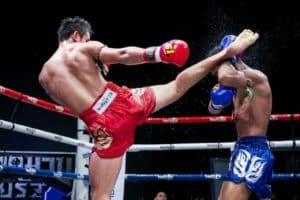
Muay Thai | Thai Boxing | Thai Combat sport | Muay Thai, Thai boxing, Combat sport of Thailand, Art of Eight Limbs, History of Muay Thai
Credit : กรมพลศึกษา


